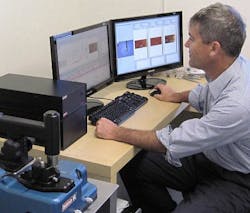IR spectroscopy and AFM combine to improve understanding of sub-micron polymer crystallization
Santa Barbara, CA--In conjunction with a development and applications team from Anasys Instruments, materials scientist Isao Noda of Procter & Gamble (Cincinnati, OH) and spectroscopist Curtis Marcott of Light Light Solutions (Athens, GA) have combined atomic force microscopy (AFM) and infrared (IR) spectroscopy to produce sub-micrometer spatial resolution IR spectra and absorption images that enable the spectroscopic characterization of microdomain-forming polymers at levels not previously accessible. The work, described in the October issue of Applied Spectroscopy, uses the AFM-IR instrument from Anasys Instruments.
The Anasys AFM-IR system uses a tunable IR laser generating pulses on the order of 10 ns to excite polymer films that have been cast onto zinc-selenide prisms. Short-duration thermomechanical waves resulting from IR absorption and corresponding thermal expansion are studied by monitoring the resulting excitation of the contact resonance modes of the AFM cantilever which in turn enables the resolution of crystalline microdomains of different sizes.
Clear and sharp spectra obtained by the AFM-IR system reveal important sub-micron information about the samples, particularly in the differences between amorphous and crystalline regions. The technique makes it possible to monitor the development of polymer crystalline structures at varying distances from a nucleation site, where the site was generated by bringing a heated AFM tip close to a specific location to locally anneal the sample.
Potential nanoIR application areas include polymer blends, multilayer films and laminates, organic defect analysis, tissue morphology and histology, subcellular spectroscopy, and organic photovoltaics.
Anasys Instruments was founded by a team of AFM industry pioneers and scientists with the goal of creating analytical tools that enable a better understanding of structure, property, and function at the nanoscale. Starting in 2006, the company says it has already launched two pioneering and award-winning material property measurement breakthroughs: nanoscale IR spectroscopy and nanoscale thermal analysis.
SOURCE: Anasys Instruments; www.anasysinstruments.com

Gail Overton | Senior Editor (2004-2020)
Gail has more than 30 years of engineering, marketing, product management, and editorial experience in the photonics and optical communications industry. Before joining the staff at Laser Focus World in 2004, she held many product management and product marketing roles in the fiber-optics industry, most notably at Hughes (El Segundo, CA), GTE Labs (Waltham, MA), Corning (Corning, NY), Photon Kinetics (Beaverton, OR), and Newport Corporation (Irvine, CA). During her marketing career, Gail published articles in WDM Solutions and Sensors magazine and traveled internationally to conduct product and sales training. Gail received her BS degree in physics, with an emphasis in optics, from San Diego State University in San Diego, CA in May 1986.
